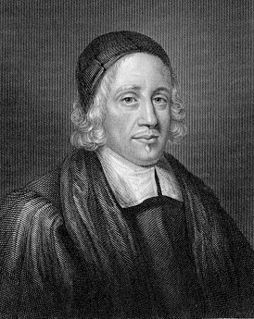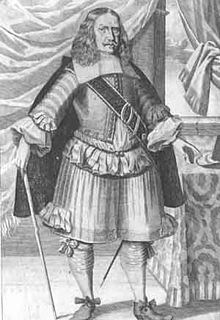Related Research Articles

The Battle of Rocroi, fought on 19 May 1643, was a major engagement of the Thirty Years' War. It was fought between a French army led by the 21-year-old Duke of Enghien and Spanish forces under General Francisco de Melo only five days after the accession of Louis XIV to the throne of France following his father's death. Rocroi is regarded as the graveyard of the myth of invincibility of the Spanish Tercios, the terrifying infantry units that had dominated European battlefields for 120 years up to that point. The battle is therefore often considered to mark the end of Spanish military greatness and the beginning of French hegemony in Europe. After Rocroi, the Spanish abandoned the Tercio system and adopted the Line infantry doctrine like the French.

John Earle was an English bishop.

The Battle of Roundway Down was fought on 13 July 1643 near Devizes, Wiltshire, during the First English Civil War. A Royalist cavalry force under Lord Wilmot won a crushing victory over the Parliamentarians under Sir William Waller.

Edmund Calamy was an English Presbyterian church leader and divine. Known as "the elder", he was the first of four generations of nonconformist ministers bearing the same name.
Stephen Marshall was an English Nonconformist churchman. His sermons, especially that on the death of John Pym in 1643, reveal eloquence and fervour. The only "systematic" work he published was A Defence of Infant Baptism, against John Tombes.

John Lightfoot was an English churchman, rabbinical scholar, Vice-Chancellor of the University of Cambridge and Master of St Catharine's College, Cambridge.

MonsieurGaston, Duke of Orléans, was the third son of King Henry IV of France and his wife Marie de' Medici. As a son of the king, he was born a Fils de France. He later acquired the title Duke of Orléans, by which he was generally known during his adulthood. As the eldest surviving brother of King Louis XIII, he was known at court by the traditional honorific Monsieur.
Willem Kieft was a Dutch merchant and the Director of New Netherland from 1638 to 1647.

Schwarzburg-Sondershausen was a small principality in Germany, in the present day state of Thuringia, with its capital at Sondershausen.

Kan'ei (寛永) was a Japanese era name after Genna and before Shōhō. This period spanned the years from February 1624 through December 1644. The reigning emperors and empress were Go-Mizunoo-tennō (後水尾天皇), Meishō-tennō (明正天皇) and Go-Kōmyō-tennō (後光明天皇).

Basil Fielding, 2nd Earl of Denbigh was a diplomat, politician and parliamentarian army officer during the English Civil War. He was the eldest son of William Feilding, 1st Earl of Denbigh and Susan Feilding, Countess of Denbigh.

Schwarzburg is one of the oldest noble families of Thuringia. Upon the death of Prince Friedrich Günther in 1971, a claim to the headship of the house passed under Semi-Salic primogeniture to his elder sister, Princess Marie Antoinette of Schwarzburg who married Friedrich Magnus V, Count of Solms-Wildenfels. Reigning over the County of Schwarzburg and founded by Sizzo I of Schwarzburg, the family split in the 16th century into the lines of Schwarzburg-Sondershausen and Schwarzburg-Rudolstadt, with the Sondershausen dying out in 1909.

The Second Battle of Middlewich was a battle of the First English Civil War that took place on 26 December 1643 in Cheshire County. In the battle, Lord Byron and the Royalists defeated a Parliamentarian army commanded by Sir William Brereton.

George II of Hesse-Darmstadt, German: Georg II von Hessen-Darmstadt was the Landgrave of Hesse-Darmstadt from 1626 to 1661. He was the son of Ludwig V and Magdalene of Brandenburg.
Anthony Burges or Burgess was a Nonconformist English clergyman, a prolific preacher and writer.
Events from the year 1566 in Ireland.

Alfonso Michele Litta was an Italian nobleman who was a Cardinal and Archbishop of Milan from 1652 to 1679.

The Battle of Aldbourne Chase was a relatively small battle of the First English Civil War that occurred on 18 September 1643. In the skirmish the Royalist cavalry led by Prince Rupert attacked the extended columns of the Parliamentarian army of the Earl of Essex at Aldbourne Chase as he was attempting to get his army to London.
In 1643, near the start of the English Civil War, Parliament set up two committees the Sequestration Committee which confiscated the estates of the Royalists who fought against Parliament, and the Committee for Compounding with Delinquents which allowed Royalists whose estates had been sequestrated, to compound for their estates – pay a fine and recover their estates – if they pledged not to take up arms against Parliament again. The size of the fine they had to pay depended on the worth of the estate and how great their support for the Royalist cause had been.
References
- ↑ Alumni Oxonienses 1500-1714, Mab-Marygold
- ↑ Horn, Joyce M. (1986), Fasti Ecclesiae Anglicanae 1541–1857, 6, pp. 16–17
| This article about a Church of England archdeacon in the Province of Canterbury is a stub. You can help Wikipedia by expanding it. |